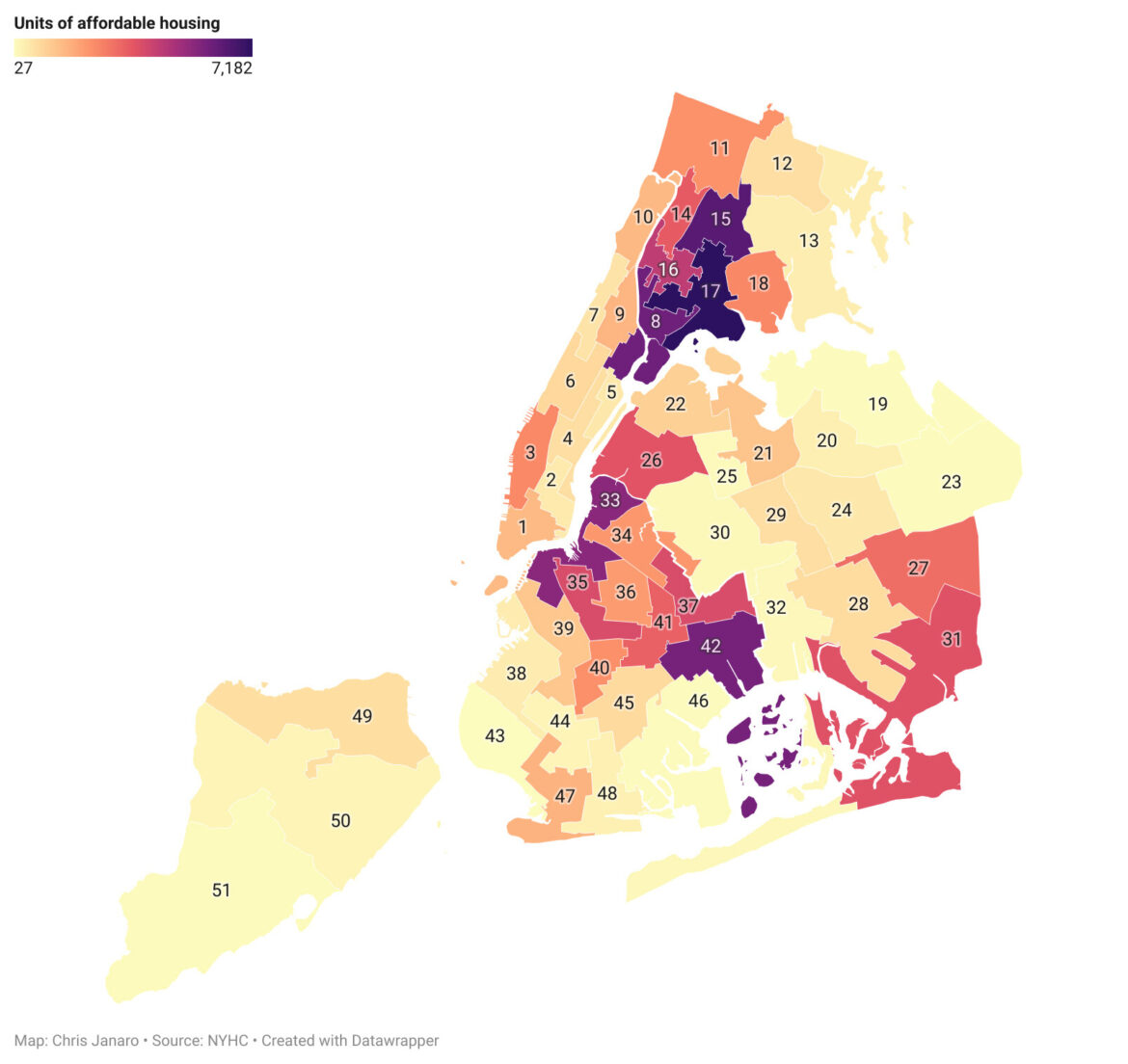
The NYC Neighborhoods Leading, and Lagging, on Affordable Housing
“The reality is that we have a housing crisis, but the South Bronx cannot bear the burden of affordable housing on its own,” said Councilmember Rafael Salamanca, whose district produced the greatest number of affordable units last year and over the past decade. “We need all 51 council districts to do their fair share.”
Chris Janaro
City data compiled by the New York Housing Conference shows how many affordable units were built in each City Council district from 2014-2023.
While New York City contends with a lack of available housing and record-high homelessness, a new report highlights which neighborhoods are bearing the brunt of affordable residential construction, and which are lagging behind.
The latest NYC Housing Tracker Report, released Thursday by the New York Housing Conference (NYHC), reveals the total number of affordable units created in each City Council district since 2014. As found in previous analyses, production was concentrated in just a handful of the city’s 51 districts, many of which were already high-density neighborhoods with higher populations of people of color.
According to the report, 70 percent of residents in the 10 districts producing the most affordable housing are Black or Latinx, compared to 30 percent of residents in the 10 districts that produced the fewest new units.
“The overall data is the same story that we reported on last time,” Rachel Fee, executive director at NYHC told City Limits. “We have communities of color in neighborhoods where land costs are lower, producing the bulk of the affordable housing, and then we have low-density communities that are really opting out from being part of the solution and producing no affordable housing or very little.”
One glaring example is Bronx Council District 17, which saw the greatest number of new affordable housing units built last year—1,266 apartments, or 8.9 percent of the city’s 14,277 unit total—matching the output of the bottom 28 districts combined.
Although the city’s housing production in 2023 was the highest in decades, it falls short of addressing the 1.4 percent housing vacancy rate revealed by the Department of Housing Preservation and Development (HPD) in February—yet there is some cause for optimism for the future, housing advocates say.
With the state’s passage of the Affordable Neighborhoods for New Yorkers (ANNY) incentive earlier this year—which replaces the expired 421-a tax benefit for developers who include affordable housing units in projects—paired with the potential approval of Mayor Eric Adams’ City of Yes for Housing Opportunity rezoning, development could not only increase, but also be more evenly distributed across the five boroughs.
“We’re not gonna see dramatic changes overnight. But I do think we have a real focus from our elected officials on providing solutions,” said Fee. Those changes, she added, are likely to allow more housing to be built in lower-density neighborhoods.
The new city budget, passed over the weekend, included a $2 billion boost in capital housing funds. And beginning next year, the city is expected to start work on a plan that will set housing production targets for each community district, the result of Council Speaker Adrienne Adams’ Fair Housing Framework passed last year.
“I think the other really important thing to know is that in addition to the tax tools, the zoning changes, we have a City Council that is demanding greater investment in affordable housing,” Fee added.
Councilmember Susan Zhuang represents District 43, which encompasses the Bensonhurst neighborhood in Brooklyn. Newly elected in 2023, Zhuang’s district placed last in the city for affordable housing construction over the last decade, with only 27 affordable homes created, something she said she’s pushing to change, especially when it comes to affordable senior housing.
“The first thing I [did] after I was elected into office, I contacted HPD, also the land use department of City Council, to try to find public space in my district able to build [on],” said Zhuang during a phone call following the report’s release. The will to build is there, but finding city-owned land available to develop has been challenging, she said.
Brooklyn Community Board 11 in her district voted against the mayor’s City of Yes for Housing Opportunity, which would relax zoning requirements to facilitate more residential development. The proposal includes the “Town Center Zoning” component, which would allow for the construction of apartments above commercial businesses.
“So we need to build taller, but at the same time, we need to have a balance,” said Zhuang, who believes there are likely some elements of the proposal that her constituents may like—just not all of them. “I have to represent my community. That’s my first priority.”
According to Councilmember Salamanca, the fear of constituent reprisal could be curtailed by the passage of City of Yes. He used former Bronx District 13 Councilmember Marjorie Velázquez as an example: after having a change of heart and endorsing a residential rezoning along Bruckner Boulevard last year, she failed to win reelection, partly due to public backlash.
“Her community was up in arms, and she lost the election because of it,” Salamanca told City Limits. If the City of Yes plan passes, he added, it would allow property owners more opportunities to build as-of-right, without having to seek the Council’s approval for a zoning change.
“I think that what the mayor is doing here is kind of striking the right balance, changing the zoning laws, which will make it easier for a councilmember in a community board to negotiate a project because once it’s law, it’s no longer, ‘Oh, we don’t want this,’” he said.
To reach the reporter behind this story, contact Chris@citylimits.org. To reach the editor, contact Jeanmarie@citylimits.org
Want to republish this story? Find City Limits’ reprint policy here.
The post The NYC Neighborhoods Leading, and Lagging, on Affordable Housing appeared first on City Limits.


